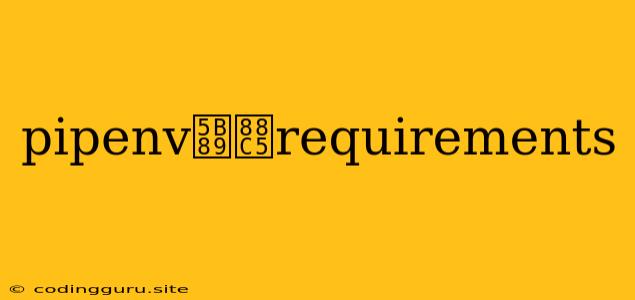Pipenv: A Streamlined Approach to Python Project Management
Pipenv is a popular tool that simplifies the process of managing Python projects, particularly by handling dependencies and creating virtual environments. It's essentially a wrapper around pip and virtualenv, combining their functionality into a single, user-friendly interface.
Why Use Pipenv?
Many Python developers find themselves juggling multiple projects with diverse dependency requirements. Pipenv shines in this scenario by providing several benefits:
- Virtual Environments: It automatically creates isolated virtual environments for each project, preventing dependency conflicts and ensuring that your projects have access to the specific libraries they need.
- Dependency Management: Pipenv manages project dependencies, ensuring that the correct versions of all required packages are installed. This is essential for reproducibility and avoiding compatibility issues.
- Lock Files: Pipenv generates a
Pipfile.lockfile, which acts as a blueprint for your project's dependencies. It precisely captures the specific versions of all packages, guaranteeing that you and your team always work with the same exact dependencies.
Understanding the Basics
Before diving into the installation of Pipenv and its associated requirements, let's clarify some key concepts:
- Pipfile: This file defines the dependencies for your Python project. It lists each package along with its desired version.
- Pipfile.lock: This file provides a detailed snapshot of your project's exact dependencies. It's crucial for ensuring that everyone working on the project uses the same versions of all packages.
- Virtual Environment: A virtual environment is a sandbox that isolates your project's dependencies from the global Python installation. This ensures that you can install different versions of packages without conflicts.
Installation
-
Installing Pipenv:
pip install pipenv -
Creating a New Project:
pipenv --threeThis command initializes a new project directory, creating the
PipfileandPipfile.lockfiles within it. The--threeflag indicates that the project should use Python 3.x. -
Installing Dependencies:
pipenv install requests beautifulsoup4This command installs the
requestsandbeautifulsoup4packages into your virtual environment. -
Activating the Virtual Environment:
pipenv shellThis activates the virtual environment for your current project, allowing you to work with its dependencies.
Key Commands
pipenv install: Installs packages into your virtual environment.pipenv uninstall: Uninstalls packages from your virtual environment.pipenv lock: Generates or updates thePipfile.lockfile, locking down your project's dependencies.pipenv graph: Displays a dependency tree, showing the relationships between your project's packages.pipenv run python: Executes a Python script within the virtual environment.
Best Practices
- Use a Virtual Environment: Always work within a virtual environment to prevent dependency conflicts.
- Maintain a Clear
Pipfile: Keep yourPipfileupdated and organized, listing only the essential packages for your project. - Lock Down Your Dependencies: Use the
pipenv lockcommand to generate aPipfile.lockfile, ensuring that your project uses the same versions of all packages. - Regularly Update Pipenv: Keep your Pipenv installation updated to benefit from the latest features and bug fixes.
Example:
Let's imagine you're working on a web scraping project that requires the requests and beautifulsoup4 libraries. You'd follow these steps:
- Create a new project:
pipenv --three - Install dependencies:
pipenv install requests beautifulsoup4 - Activate the virtual environment:
pipenv shell - Write your scraping script: You can now write your code, accessing the installed libraries from the activated virtual environment.
Conclusion:
Pipenv is a powerful tool that simplifies Python project management, making it easier to handle dependencies, maintain consistency across different environments, and collaborate effectively on projects. By embracing Pipenv, you can streamline your Python development workflow, ensuring that your projects run smoothly and are easily reproducible.
